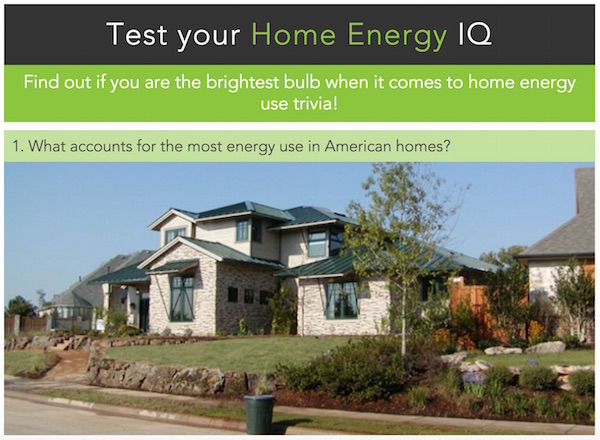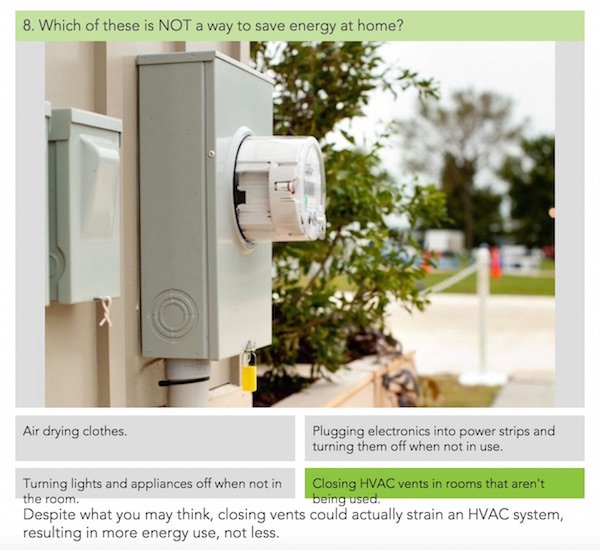A Little Home Energy Quiz from the DOE

I found this little quiz on Twitter the other day. I got 9 correct out of 12, but I’d like to dispute one of my wrong answers. One of the answers surprised me. And I was glad to see one of them support an article I wrote in 2014. If you want to take the quiz before reading my quick take on it, go take the quiz now.
While you do that, I’ll sit here and wait.
And maybe hum a little bit. Bamh Bamh Bamh. Bamh Bamh ba Bamh. (Know that tune?)
Think I’ll check my email now.
Done? Good. I’ll make this quick.
First, the question that surprised me was about which state uses the most electricity per household. The choices are Florida, California, New York, and Louisiana. I thought it would be a state with a lot of air conditioning and chose Florida. But the winner is… Louisiana. Huh! My old home state is the worst at over 15 thousand kWh per year. On the other end, Hawaii was the best at about 6 thousand kWh per year.
The question I dispute was related to thermostat setbacks. They asked what percent savings you can see if you set the thermostat back 10° F for 8 hours per day. Their answer is 10%. I chose 5%.
When I wrote about energy savings from thermostats a few years ago, I cited some numbers from the king of home energy data, Michael Blasnik. He found in his earlier work with utilities that setbacks save 5 to 8%. So I chose 5%. Of course, it depends on what house your thermostat is in. The better insulated and more airtight the house, the less your savings will be. The more of an energy hog your home is, the more you can save.
Finally, the question that supported what I wrote in 2014. Here. I’ll just throw it at you.

It’s pretty obvious that the other three answers DO save energy so even if you don’t know anything about the issue of closing HVAC vents. Right? So this is a great way to surprise people and teach them while also letting them get the right answer. If you want to understand the reasoning behind the correct answer, go read my article on closing vents in unused rooms. It’s an important topic and may save you some money if you’ve been thinking of buying those cool “smart vents” you saw on the Web.
The other questions in the quiz are good questions and you might learn a thing or two from them. Check it out. I ought to put together a building science quiz and post it here. If you have specific questions you think I should ask, post them in the comments below or send them to me in an email at evinfo@energyvanguard.com.
Related Articles
If You Think Thermostat Setbacks Don’t Save Energy, You’re Wrong!
Can You Save Money by Closing HVAC Vents in Unused Rooms?
Total Energy Use Down in US, Wind & Solar Up
NOTE: Comments are moderated. Your comment will not appear below until approved.
This Post Has 16 Comments
Comments are closed.

I also missed three. And I
I also missed three. And I also think they are wrong on one – the last one regarding LEDs. LEDs do NOT emit light in only one direction (and I knew what LED actually stood for, but that’s not as wrong as saying that light is only emitted in one direction – that’s just crazy).
Charles, my phsics days are
Charles, my phsics days are nearly 2 decades in my past now. I remembered that LEDs are pn junctions and the frequency of light emitted depends on the band gap, but I didn’t recall anything about directionality. So I went to Wikipedia just now and found this:
I pondered about that LED
I pondered about that LED answer too. Truth is it’s kind of half right. Early LEDs, the kind still used in flashlights and other forms of directional lighting, generally had a tiny reflector built in to optimize the directional light output. It took a while for the technology to evolve to allow dispersed lighting. Which is why it took so long to come up with a standard ES replacement bulb.
Allison, I got the setback and state energy use questions wrong too, with the same ‘wrong’ answers. What was your third? I was wrong on energy star savings.
James, we missed all the same
James, we missed all the same ones. My third wrong answer was also about ENERGY STAR savings. I said $921 instead of $750.
I too thought Florida would
I too thought Florida would win it. But I sorta wondered if it were a trick question since I could make a logic case for any of them but Lousiana, so why would it be there, except if it were the one!
I agree that the setback question is irritating. It depends on what kind of HVAC system you have! If its’ a heat pump, don’t set it back at all, I always thought. That’s the challenge of boiling down complex information that varies a lot across the country and is going to a huge audience into a simple concept.
It also kinda irked me that the question about tankless water heaters showed a heat pump water heater.
Yeah, some of the other
Yeah, some of the other pictures were a bit odd, too.
About that vent complaint. I
About that vent complaint. I suggest that is really a damning indictment of AC duct systems and not the vent closing per se. Before we go further, I agree that many people close vents without any knowledge of how that affects the air system (e.g. External Static Pressure, watts vs. ESP) and those people fail to achieve their desired result.
But don’t pretend the air flow required to maintain temperature, is the same for high and low temperatures. And while I am not sure, I doubt the problem can be solved by a once-per-season change in dampers. My house experience says the problem is slipperier than that.
I know a HVAC professional who was a beta tester for ECOVENT and he says it basically does what it says, adjusting airflow at each register through a range which does not result in excessive ESP, and does a better job at maintaining target temperature in each room. Let’s not paint the entire industry with too broad a brush.
For years I have been trying to address a condition of certain room temperatures being uncomfortable. This includes a parade of HVAC pros who have measured air flow, sealed duct systems, most if not all the professional normal activities (I did a per-room Manual J using the old HVAC-CALC). The evidence points to dramatically different air flow being required between heating and cooling conditions… something none of the professionals have brought up.
Mark, it is absolutely a
Mark, it is absolutely a “damning indictment” of duct systems. That’s why people should just get their ducts fixed instead of trying to rely on bandaids like smart vents. Will smart vents cause damage in every application? No. Can they ever be a reasonable, low-cost solution? Maybe. I prefer to see solutions that start by addressing the root causes, though, and smart vents generally aren’t promoted that way.
I missed 3 also but there are
I missed 3 also but there are 13 questions now and it said my score was 10/1 (which I did not understand). I missed the state question also, I wonder if it has to do with newer/better construction due to a more affluent population in Florida. Just a thought.
Lee, you’re right! I hadn’t
Lee, you’re right! I hadn’t noticed there are really 13 questions. I assumed their arithmetic was correct, but I should have been suspicious of even that part. In my second attempt (I answered only the first 3 or 4 at first and came back to it later), I clearly missed two but my score at the bottom said I got 11 right and 1 wrong. Hmmmm. Good catch!
Yeah, the Florida/Louisiana thing could be related to income. One thing that argues against Louisiana compared to Florida, though, is that the former (I believe) has more natural gas. I know in the 13 years I lived there, a lot of the places I lived had gas water heaters and many had gas heat.
I missed the Q’s on E*
I missed the Q’s on E* appliance savings and t’stat setback. I think multiple choice statistical questions are dumb when the choices are relatively close together. The answers have no bearing on any given home.
I correctly guessed the question about highest electric consumption Louisiana. With Louisiana and Florida listed among the choices, I figured it could be either one. I chose the former only because I thought it might be a trick question (I imagine most people would chose Florida, right?)
David, it seems a lot of us
David, it seems a lot of us are missing the same 2 or 3 questions. And yeah, based on comments here and a couple of emails I’ve gotten, it seems more people are choosing Florida than Louisiana.
I couldn’t pass up an
I couldn’t pass up an opportunity to let everyone know the wife and I just returned Tuesday from 10 days on the Big Island, where rooftop solar is ubiquitous, A/C is rare in most residences and electricity from diesel (some geothermal) comes through the meter at, wait for it…$0.48/kWh (!!!).
Wish I could say the same
Wish I could say the same about our recent visit to Eleuthera in the Bahamas. Diesel generated grid power averaging about 30c/kWh, not a single wind or solar farm or even rooftop solar installation did I see despite steady trade winds and ten hours of sunshine most days. I was told that not only is there no govt. support for renewables, solar panels were taxed at 50% until just a few years ago. Beautiful island, lovely, struggling people.
I too picked CA, thinking of
I too picked CA, thinking of all the personal devices in use. Never considered Louisiana, mostly below sea level, must have a lot of sump pumps.
@Ed, cooling loads drive
@Ed, cooling loads drive Louisiana’s electrical consumption (as well as a lack of code enforcement I’m told). Much of California has relatively small cooling loads and energy codes are much more stringent. Even some plug loads are regulated.